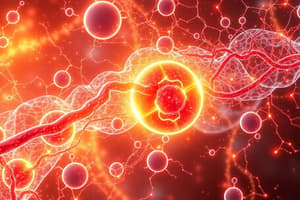Podcast
Questions and Answers
What is the primary function of ATP synthase in the electron transport chain?
What is the primary function of ATP synthase in the electron transport chain?
- To act as an uncoupling agent in oxidative phosphorylation
- To transport electrons across the inner mitochondrial membrane
- To form ATP by utilizing the energy from proton translocation (correct)
- To generate heat by dissipating energy not trapped in ATP
What occurs to energy released in the electron transport chain if it is not trapped in ATP?
What occurs to energy released in the electron transport chain if it is not trapped in ATP?
- It is utilized in anabolic pathways throughout the body
- It is stored as glycogen for later use
- It is converted to FADH2 for further reactions
- It is released in the form of body heat (correct)
Which subcomplex of ATP synthase is primarily involved in ATP production?
Which subcomplex of ATP synthase is primarily involved in ATP production?
- Fo subcomplex
- F1 subcomplex (correct)
- Gamma subunit
- C protein subunits
Which of the following statements is true regarding the P-O ratios for NADH and FADH2?
Which of the following statements is true regarding the P-O ratios for NADH and FADH2?
What is the role of the Fo subcomplex in ATP synthase?
What is the role of the Fo subcomplex in ATP synthase?
What is the significance of the glycerol-3-phosphate shuttle system?
What is the significance of the glycerol-3-phosphate shuttle system?
Which component of ATP synthase is primarily responsible for the rotary motion during ATP synthesis?
Which component of ATP synthase is primarily responsible for the rotary motion during ATP synthesis?
What characterizes the binding change mechanism of ATP synthesis?
What characterizes the binding change mechanism of ATP synthesis?
What occurs during the exergonic reaction A → B?
What occurs during the exergonic reaction A → B?
What purpose does ATP serve in energy metabolism?
What purpose does ATP serve in energy metabolism?
Which bond in ATP is indicated by the squiggle symbol ~(E)?
Which bond in ATP is indicated by the squiggle symbol ~(E)?
What is the role of creatine phosphate in energy production?
What is the role of creatine phosphate in energy production?
Why is the reaction C → D not occurring simultaneously with A → B?
Why is the reaction C → D not occurring simultaneously with A → B?
What reaction exemplifies substrate level phosphorylation?
What reaction exemplifies substrate level phosphorylation?
What happens to the energy released during the reaction A → B if it is not captured?
What happens to the energy released during the reaction A → B if it is not captured?
How is ATP synthesized from ADP during the reaction involving creatine phosphate?
How is ATP synthesized from ADP during the reaction involving creatine phosphate?
What is the energy released when ATP is hydrolyzed to ADP and Pi?
What is the energy released when ATP is hydrolyzed to ADP and Pi?
What role does pyrophosphate (PPi) play in a reaction involving AMP?
What role does pyrophosphate (PPi) play in a reaction involving AMP?
How much energy is released when AMP and PPi are completely hydrolyzed?
How much energy is released when AMP and PPi are completely hydrolyzed?
What does substrate level phosphorylation directly involve?
What does substrate level phosphorylation directly involve?
What is the primary source of energy generation in the body?
What is the primary source of energy generation in the body?
What is the change in Gibbs free energy (ΔGo’) for the reaction Glucose + Pi → Glucose 6-phosphate + H2O?
What is the change in Gibbs free energy (ΔGo’) for the reaction Glucose + Pi → Glucose 6-phosphate + H2O?
What is the typical P-O ratio in oxidative phosphorylation?
What is the typical P-O ratio in oxidative phosphorylation?
Which enzyme is responsible for converting glucose to glucose 6-phosphate?
Which enzyme is responsible for converting glucose to glucose 6-phosphate?
What primarily drives ATP formation in oxidative phosphorylation?
What primarily drives ATP formation in oxidative phosphorylation?
Which complexes in the electron transport chain pump protons to the intermembrane space?
Which complexes in the electron transport chain pump protons to the intermembrane space?
What theory explains the mechanism of oxidative phosphorylation?
What theory explains the mechanism of oxidative phosphorylation?
What is generated as a result of the proton pumping in the mitochondria?
What is generated as a result of the proton pumping in the mitochondria?
Where do the protons re-enter the mitochondrial matrix during ATP formation?
Where do the protons re-enter the mitochondrial matrix during ATP formation?
Which of the following is NOT a source of NADH and FADH2 in metabolism?
Which of the following is NOT a source of NADH and FADH2 in metabolism?
Which statement about complex II in the electron transport chain is true?
Which statement about complex II in the electron transport chain is true?
What is the primary role of ATP synthase in oxidative phosphorylation?
What is the primary role of ATP synthase in oxidative phosphorylation?
What does a negative ΔG indicate about a reaction?
What does a negative ΔG indicate about a reaction?
What occurs when ΔG is zero?
What occurs when ΔG is zero?
Which statements correctly describe ΔGo?
Which statements correctly describe ΔGo?
How can endergonic reactions proceed?
How can endergonic reactions proceed?
What is the relationship between exergonic and endergonic reactions?
What is the relationship between exergonic and endergonic reactions?
What characterizes a reaction with a high magnitude of ΔG when it is positive?
What characterizes a reaction with a high magnitude of ΔG when it is positive?
When is a reaction considered isoergonic?
When is a reaction considered isoergonic?
What does an endergonic reaction require?
What does an endergonic reaction require?
Which statement is true about exergonic reactions?
Which statement is true about exergonic reactions?
What defines an exergonic reaction based on standard free energy change?
What defines an exergonic reaction based on standard free energy change?
Flashcards are hidden until you start studying
Study Notes
Overview of Oxidative Phosphorylation
- NADH and FADH2 are produced in multiple metabolic processes, including glycolysis, beta-oxidation of fatty acids, the TCA cycle, and other oxidative reactions.
- Electrons transfer from NADH to O2 occurs in stages through large protein complexes embedded in the inner mitochondrial membrane.
- Complexes I, III, and IV use the energy from electron transfer to pump protons to the intermembrane space.
- The pumping of protons creates an electrochemical gradient or proton-motive force.
- Protons re-enter the mitochondrial matrix through ATP synthase, causing ATP to be generated.
- The P-O ratio for NADH is 2.5. This means 2.5 ATP molecules are produced per NADH molecule.
- The P-O ratio for FADH2 is 1.5. This means 1.5 ATP molecules are produced per FADH2 molecule.
Chemiosmotic Coupling Theory
- This theory explains how oxidative phosphorylation works.
- Energy from oxidation of components in the electron transport chain is coupled to proton translocation across the inner mitochondrial membrane.
ATP Synthase (Complex V)
- Functions as a rotary motor to form ATP.
- Embedded in the inner mitochondrial membrane.
- Composed of two subcomplexes:
- Fo subcomplex: Contains a disk of C protein subunits, the gamma subunit attached to Fo and F1, and the oligomycin sensitivity conferring enzyme (OSCP).
- F1 subcomplex: Contains three alpha subunits and three beta subunits.
- Fo spans the membrane and serves as a proton channel.
- F1's beta subunit is the site of ATP synthesis.
Electron Shuttle Systems
- Two known shuttle systems:
- Glycerol-3-phosphate shuttle system: Simpler system using glycerol-3-PO4+ dehydrogenase. Major shuttle system in the brain and myocytes. Uses FAD as a mitochondrial electron carrier with a P-O ratio of 1.5.
- Malate-aspartate shuttle system: More complex system. Uses NAD as a mitochondrial electron carrier with a P-O ratio of 2.5.
ΔG: Change in Free Energy
- Free energy (G) is a measure of useful energy in a system.
- ΔG is the change in free energy and reflects the chemical potential of a system.
- ΔG is negative for exergonic reactions (energy released) and positive for endergonic reactions (energy absorbed).
- ΔG of zero indicates that the system is at equilibrium.
- ΔGo' is the standard free energy change at pH 7.0.
Standard Free Energy Change
- Endergonic reactions require energy (ΔGo' is positive).
- Exergonic reactions release energy (ΔGo' is negative).
- Isoergonic reactions are at equilibrium (ΔGo' is zero).
Substrate Level Phosphorylation
- Produces ATP through direct transfer of a phosphate group from a substrate to ADP.
- Only produces 1 ATP molecule at a time.
- Does not involve electron transport chain.
Importance of ATP
- Intermediate position of ATP allows it to play a critical role in energy transfer.
- ATP allows the coupling of thermodynamically unfavorable reactions to favorable ones.
Coupling Exergonic and Endergonic Reactions
- Energy released from an exergonic reaction can be used to drive an endergonic reaction, by transferring energy via a high-energy compound like ATP.
Creatine Phosphate
- Found in skeletal muscles.
- Acts as an energy source.
- Creatine kinase (CK) facilitates the reversible transfer of a phosphate group from creatine phosphate to ADP, producing ATP.
Importance of Pyrophosphate (PPi)
- Pyrophosphate can be further hydrolyzed to release additional energy (-4.6 kJ/mol).
- When AMP + PPi are completely hydrolyzed, the overall energy release is -12.3 kJ/mol.
- The presence of PPi in reactions can make them irreversible.
Studying That Suits You
Use AI to generate personalized quizzes and flashcards to suit your learning preferences.



